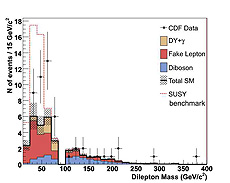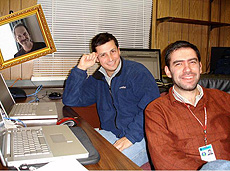Trilepton events using a blind analysis
 |
| The dilepton mass distribution of electron- or muon-pair + lepton events for the Standard Model background, CDF data and a SUSY benchmark (stacked on top of the Standard Model background) in the signal region. |
One way physicists try to make the big discovery is by searching for the unexpected — unexpected by the current accepted theories and, very often, even unexpected by new theories. The question they face is, "Where do we look for the unexpected?". The answer is usually, "Search for a rare signal in places where you understand the background well." This search looks for the production of three leptons plus missing energy and is characterized by three well-understood backgrounds. The lepton class of particles comprises electrons, muons and taus.
CDF analysts studied extensively all backgrounds, both in counting and kinematics, in a large number of dilepton and trilepton control regions before they were convinced they understood the Standard Model as it manifests itself in multilepton final states. They didn't allow themselves to look at the signal region before this process was fully concluded, making this a "blind" search for new physics.
The final step was to uncover the signal region and study the observed events. The two highest-energy leptons must be an electron or a muon, while the lowest-energy lepton can be an electron, muon or a tau. An excess of trilepton events was observed at low dilepton mass. Scientists observed 34 electron pairs with a third lepton when only 20 ± 4 were expected. They also observed 19 muon pairs with a third lepton when 13 ± 2 were expected. The results are displayed in the figure.
The probability that such an excess over the same energy range (between 10 and 85 GeV/c2) was produced by a statistical fluctuation from background events anywhere in the spectrum is 3.2 percent (1.85 sigma effect), which is not threatening to the Standard Model. Although new physics was not observed, the understanding of Standard Model multileptonic processes at CDF reached an unprecedented level, which could stimulate new searches for even more unexpected signals.
Learn more
—edited by Andy Beretvas
 |
| These CDF physicists contributed to this data analysis.
From left: Michael Gold, Marcelo Vogel and John Strologas, all from the University of New Mexico.
|
|